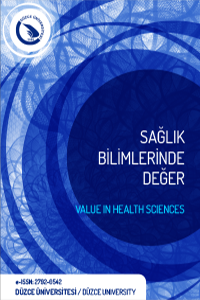Jel Eyeliner ile Oküler Konfor İlişkisinin Değerlendirilmesi
OSDİ, keratoconjunctivitis sicca, mikrokapsül, eyeliner
Evaluation of the Relationship between the Gel Eyeliner and Ocular Comfort
OSDI, Keratoconjunctivitis sicca, microcapsule, eyeliner,
___
- Murube J. Ocular cosmetics in modern times. Ocul Surf. 2013; 11(2): 60-4.
- Mulhern R, Fieldman G, Hussey T, Lévêque JL Pineau P. Do cosmetics enhance female Caucasian facial attractiveness. Int. J. Cosmet Sci. 2003; 25(4): 199-205.
- Ng A, Evans K, North RV, Jones L, Purslow C. Impact of eye cosmetics on the eye, adnexa, and ocular surface. Eye Contact Lens. 2016; 42(4): 211-20.
- Statista.com [Internet]. Usage of eye liner in the us trend. [Updated: 2021 June 16; Cited: 2021 Jul 29]. Available from: https://www.statista.com/statistics/285917/usage-of-eye-liner-in-the-us-trend
- Draelos ZD. Special considerations in eye cosmetics. Clin Dermatol. 2001; 19: 424-30.
- Hamilton T, De Gannes GC. Allergic contact dermatitis to preservatives and fragrances in cosmetics. Skin Therapy Lett. 2011; 16: 1-4.
- Wolf R, Wolf D, Tuzun B, Tuzun Y. Contact dermatitis to cosmetics. Clin Dermatol. 2001; 19: 502-15.
- Adams RM, Maibach HI. A five-year study of cosmetic reactions. J Am Acad Dermatol. 1985; 13: 1062-69.
- Clifford L, Jeffrey M, Maclean H. Lacrimal sac pigmentation due to mascara. Eye. 2011; 25: 397-8.
- Shields JA, Marr BP, Shields CL, Eagle Jr. RC. Conjunctival mascaroma masquerading as melanoma. Cornea. 2005; 24: 496-7.
- Ciolino JB, Mills DM, Meyer DR. Ocular manifestations oflong-term mascara use. Ophthal Plast Reconstr Surg. 2009; 25: 339-41.
- Ng A, Evans K, North RV, Purslow C. Migration of cosmetic products into the tear film. Eye Contact Lens. 2015; 41(5): 304-9.
- Hunter M, Bhola R, Yappert MC, Borchman D, Gerlach D. Pilot study of the influence of eyeliner cosmetics on the molecular structure of human meibum. Ophthalmic Res. 2015; 53(3): 131-5.
- Ng A, Evans K, North R, Purslow C. Eye cosmetic usage and associated ocular comfort. Ophthalmic Physiol Opt. 2012; 32(6): 501-7.
- Craig JP, Nelson JD, Azar DT, Belmonte C, Bron AJ, Chauhan SK, et al. TFOS DEWS II report executive summary. Ocul Surf. 2017; 15(4): 802-12.
- Tong L, Waduthantri S, Wong TY, Saw SM, Wang JJ, Rosman M, Lamoureux E. Impact of symptomatic dry eye on vision-related daily activities: the Singapore Malay Eye Study Eye. 2010; 24: 1486-91.
- Stapleton F, Alves M, Bunya VY, Jalbert I, Lekhanont K, Malet F, et al. TFOS DEWS II Epidemiology Report Ocul Surf. 2017; 15(3): 334-65.
- Wang MTM, Craig JP. Investigating the effect of eye cosmetics on the tear film: current insights, Clinical Optometry. 2018; 10: 33-40.
- Lozato PA, Pisella PJ, Baudouin C. The lipid layer of the lacrimal tear film: physiology and pathology. J Fr Ophtalmol. 2001; 24: 643-58.
- Guillon M, Maissa C, Dry eye symptomatology of soft contact lens wearers and nonwearers. Optom Vis Sci. 2005; 82: 829-34.
- Malik A, Claoue C. Transport and interaction of cosmetic product material within the ocular surface: beauty and the beastly symptoms of toxic tears. Cont. Lens Anterior Eye. 2012; 35(6): 247-59.
- Schiffman RM, Christianson MD, Jacobsen G, Hirsch JD, Reis BL. Reliability and validity of the ocular surface disease index. Arch Ophthalmol. 2000; 118: 615-21.
- Nguyen TA, Rajendran S. Current commercial nanocosmetic products, In book: Nanocosmetics: Fundamentals, Applications and Toxicity. Edition:1 Chapter:17, Elsevier; 2020.
- Chowhan M, Lang JC, Missel P. Ophthalmic preparations. In: Remington: the Science and Practice of Pharmacy (Allen LV Jr , editor.) 22nd edition, Pharmaceutical Press: PA, USA, 2012; pp. 850-70.
- Focusquimica.com [Internet]. Tagra-biotechnologies. [Updated: 2021 July 16; Cited: 2021 September 25]. Available from:http://www.focusquimica.com/representadas/tagra-biotechnologies/especialidades/
- Yayın Aralığı: Yılda 3 Sayı
- Başlangıç: 2022
- Yayıncı: Düzce Üniversitesi
Adölesanlarda Akdeniz Diyetine Uyum ile Meyve ve Sebze Tüketim Davranışlarının Değerlendirilmesi
Nural ERZURUM ALİM, Gözde ÇALIŞKAN, Zehra Nur BEŞLER
Mülteci Ruh Sağılığında Güncel Yaklaşımlar
Taha Can TUMAN, Onur HURŞİTOĞLU
Meme Kanseri Hastalarında hTERT Gen Ekspresyonunun Klinikopatolojik Önemi
Ebubekir DİRİCAN, Burak KANKAYA, Zeynep TATAR
Aslı KURTGÖZ, Selin KESKİN KIZILTEPE
Hemşirelerde İşe Bağlı Gerginlik Düzeyi ile Tıbbi Hata Eğilimi Arasındaki İlişki
Birgül CERİT, Hümeyra HANÇER TOK, Gülnur TEMELLİ
Jel Eyeliner ile Oküler Konfor İlişkisinin Değerlendirilmesi
